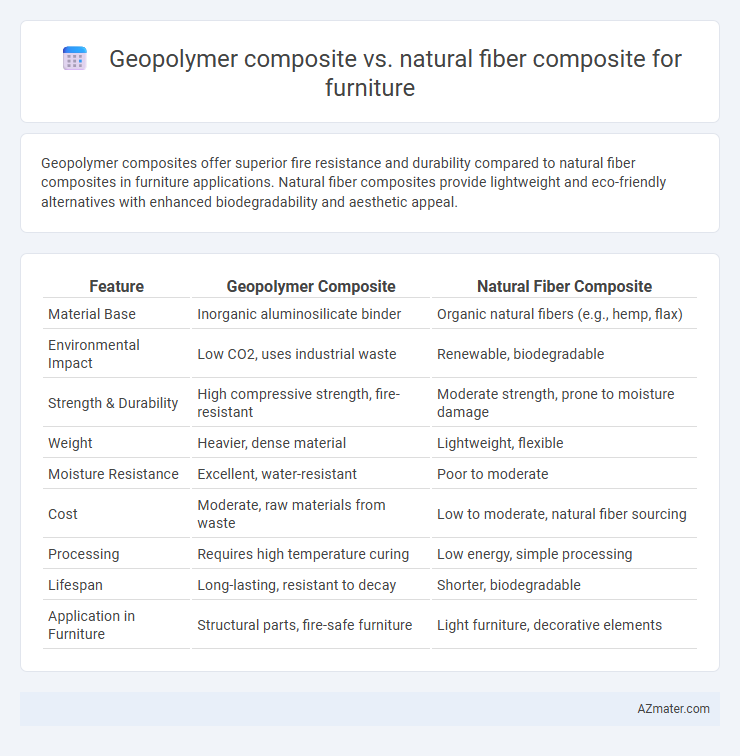Geopolymer composites offer superior fire resistance and durability compared to natural fiber composites in furniture applications. Natural fiber composites provide lightweight and eco-friendly alternatives with enhanced biodegradability and aesthetic appeal.
Table of Comparison
| Feature | Geopolymer Composite | Natural Fiber Composite |
|---|---|---|
| Material Base | Inorganic aluminosilicate binder | Organic natural fibers (e.g., hemp, flax) |
| Environmental Impact | Low CO2, uses industrial waste | Renewable, biodegradable |
| Strength & Durability | High compressive strength, fire-resistant | Moderate strength, prone to moisture damage |
| Weight | Heavier, dense material | Lightweight, flexible |
| Moisture Resistance | Excellent, water-resistant | Poor to moderate |
| Cost | Moderate, raw materials from waste | Low to moderate, natural fiber sourcing |
| Processing | Requires high temperature curing | Low energy, simple processing |
| Lifespan | Long-lasting, resistant to decay | Shorter, biodegradable |
| Application in Furniture | Structural parts, fire-safe furniture | Light furniture, decorative elements |
Introduction to Geopolymer and Natural Fiber Composites
Geopolymer composites are inorganic polymer materials formed by the reaction of aluminosilicate powders with alkaline solutions, offering enhanced fire resistance, durability, and environmental sustainability compared to traditional composites. Natural fiber composites integrate renewable plant-based fibers such as jute, flax, or hemp with polymer matrices, providing lightweight, biodegradable, and cost-effective alternatives ideal for eco-friendly furniture applications. Both materials exhibit unique mechanical and thermal properties, positioning them as innovative solutions in sustainable furniture manufacturing.
Material Composition and Structure
Geopolymer composites for furniture utilize inorganic aluminosilicate binders derived from industrial by-products such as fly ash or metakaolin, offering high thermal stability and mechanical strength. Natural fiber composites consist of renewable plant fibers like jute, hemp, or flax embedded in polymeric matrices, providing lightweight and biodegradable options with good tensile properties. The distinct structural composition of geopolymer composites results in a rigid, fire-resistant material, while natural fiber composites exhibit enhanced flexibility and eco-friendly characteristics due to their fiber-reinforced polymer network.
Environmental Impact and Sustainability
Geopolymer composites offer significant environmental advantages over natural fiber composites in furniture manufacturing due to their lower carbon footprint and use of industrial by-products like fly ash or slag, reducing landfill waste and reliance on virgin materials. Natural fiber composites, while biodegradable and renewable, often require extensive agricultural inputs and processing, which can impact land use and water resources. Both materials promote sustainability, but geopolymer composites provide enhanced durability and fire resistance, extending furniture lifespan and minimizing resource consumption over time.
Mechanical Properties and Performance
Geopolymer composites exhibit superior mechanical properties, including higher compressive strength and enhanced thermal stability, compared to natural fiber composites used in furniture applications. Natural fiber composites offer better flexibility, impact resistance, and sustainability due to renewable fibers like jute, hemp, or flax, but typically have lower stiffness and durability than geopolymer-based materials. Performance-wise, geopolymer composites provide improved fire resistance and long-term dimensional stability, making them ideal for structural furniture components, while natural fiber composites excel in lightweight and eco-friendly designs.
Design Flexibility and Aesthetics
Geopolymer composites offer high design flexibility due to their moldability and ability to incorporate intricate textures and finishes, making them suitable for modern, minimalist furniture aesthetics. Natural fiber composites provide warm, organic textures and unique fiber patterns that enhance the visual appeal of sustainable and rustic furniture designs. Both materials allow innovative customization, but geopolymer composites excel in achieving sleek, industrial looks, while natural fiber composites emphasize natural beauty and eco-friendly appearance.
Durability and Lifespan in Furniture Applications
Geopolymer composites exhibit superior durability and longer lifespan compared to natural fiber composites in furniture applications due to their enhanced resistance to moisture, fire, and chemical degradation. Natural fiber composites tend to absorb moisture, leading to potential swelling, fungal growth, and reduced mechanical performance over time. The inorganic matrix in geopolymer composites provides stable structural integrity, making them ideal for long-lasting, maintenance-free furniture solutions.
Cost Comparison and Market Availability
Geopolymer composites typically offer a cost advantage over natural fiber composites due to lower raw material expenses and enhanced durability, reducing maintenance costs in furniture applications. Natural fiber composites, while eco-friendly, can face higher price volatility influenced by agricultural resource availability and processing complexity. Market availability favors natural fiber composites with widespread supply chains and established demand, whereas geopolymer composites remain niche but are gaining traction with growing interest in sustainable and fire-resistant furniture materials.
Processing and Manufacturing Techniques
Geopolymer composites used in furniture manufacturing involve alkali-activated binders with inorganic materials, cured at ambient or elevated temperatures, enabling precise mold casting and minimal shrinkage. Natural fiber composites combine renewable fibers such as jute or hemp with thermoset or thermoplastic matrices, typically processed through hand lay-up, compression molding, or injection molding, requiring careful moisture control to prevent degradation. Advanced techniques like vacuum bagging and resin transfer molding improve fiber wetting and structural integrity in natural fiber composites, whereas geopolymer composites benefit from faster setting times and enhanced fire resistance during processing.
Application Case Studies in Furniture Design
Geopolymer composites demonstrate superior fire resistance and durability in furniture applications, as evidenced by case studies in modern office furnishings where their structural integrity outperforms traditional natural fiber composites. Natural fiber composites offer enhanced sustainability and lightweight features, making them ideal for ergonomic chair designs and eco-friendly furniture prototypes. Case studies reveal that integrating geopolymer composites with natural fibers can optimize both strength and environmental impact in innovative furniture design.
Future Prospects and Innovations in Composite Furniture
Geopolymer composites offer enhanced durability, fire resistance, and environmental sustainability, making them ideal for long-lasting furniture applications, while natural fiber composites contribute lightweight, biodegradable, and cost-effective solutions with renewable resources. Emerging innovations in composite furniture include the integration of smart materials, improved fiber-matrix adhesion techniques, and 3D printing, which enhance mechanical properties and design flexibility for customized, eco-friendly products. Future prospects emphasize hybrid composites combining geopolymer matrices with natural fibers to optimize strength, reduce carbon footprint, and cater to growing consumer demand for sustainable and high-performance furniture.

Infographic: Geopolymer composite vs Natural fiber composite for Furniture
 azmater.com
azmater.com